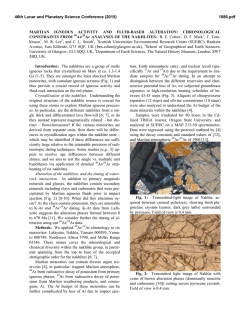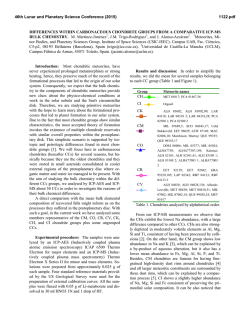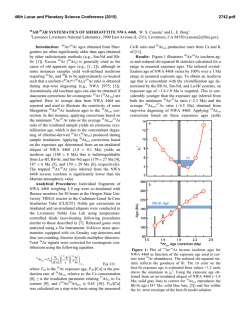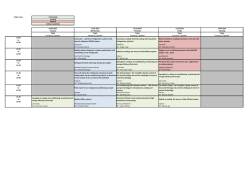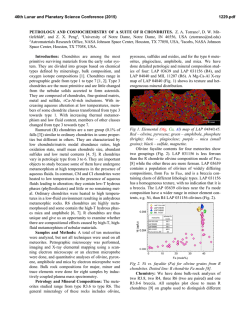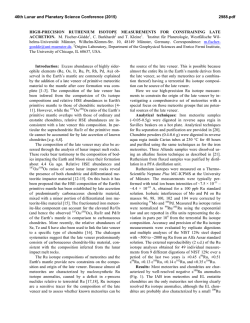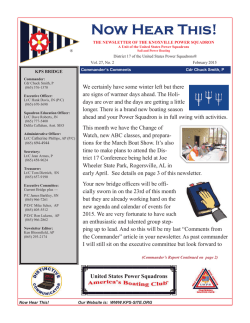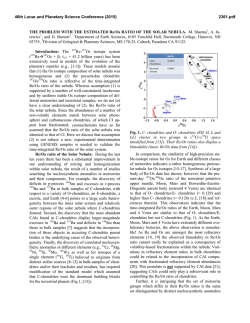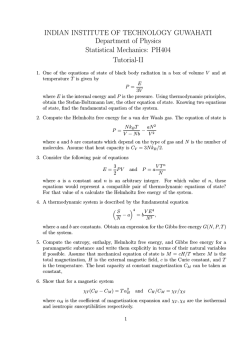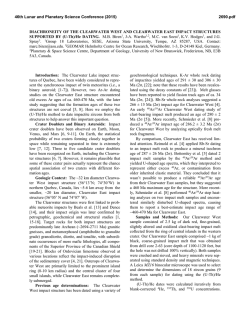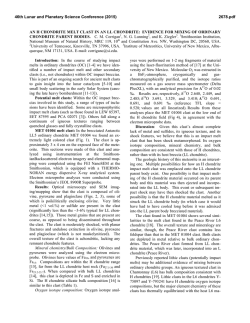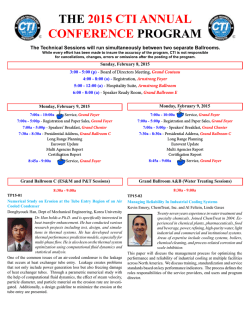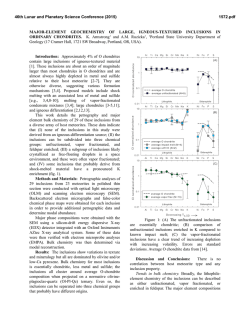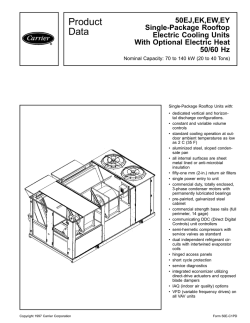
COOLING OF THE H CHONDRITE PARENT BODY: EXAMINATION
46th Lunar and Planetary Science Conference (2015) 1876.pdf COOLING OF THE H CHONDRITE PARENT BODY: EXAMINATION AND ASSESSMENT OF 40 Ar/39Ar AGE DATA. B. E. Cohen1, D. F. Mark1, M. R. Lee2, and C. L. Smith3, 1Scottish Universities Environmental Research Centre (SUERC), Rankine Avenue, East Kilbride, G75 0QF, UK ([email protected]), 2 School of Geographical and Earth Sciences, University of Glasgow, G12 8QQ, UK, 3Department of Earth Sciences, The Natural History Museum, London, SW7 5BD, UK. Introduction: Due to the large original size of the H chondrite parent – estimated at ca. 100 km – its interior underwent significant heating and metamorphic recrystallization as a result of accretion and decay of short-lived radionuclides [1-3] (Fig. 1). In a bolide that was not substantially influenced by impacts or an irregular distribution of heat sources, the interior portions are expected to have witnessed higher degrees of heating and recrystallization (petrologic type 6, Fig. 1) than material found closer to the surface, which cooled substantially faster and underwent little or no recrystallization (petrologic types 3 and 4, Fig. 1). Fig. 1: (a) Onion-shell model for the cooling of the H chondrite parent body [1], showing the zonation from low to high petrologic type (3-6, respectively). (b) Schematic diagram showing cooling curves for petrologic types 3 to 6, and times recorded by various thermochonometers. Using a combination of Pb-Pb, 244Pu fission track, and 40Ar/39Ar chronology, Trieloff et al. [1] found that the cooling ages for all three chronometers formed a consistent pattern, with the H4 chondrites yielding comparatively old ages (ca. 4550-4560 Ma), with the H6 samples cooling up to 150 Ma later. This distribution of ages is consistent with a simple unperturbed cooling history for the H chondrite parent body, and has been termed the onion-shell model [1]. Other studies of the H chondrites have, however, indicated that the cooling of the parent body may not be this straightforward. In particular, metal-cooling rates from some stones indicate more rapid cooling than would be expected from the onion-shell model, which implies substantial impacts disturbed the early thermal history of at least part of the parent body [4]. We have sought to better constrain and understand the cooling history of the H chondrite parent body by two approaches. Firstly, we are compiling results from previous 40Ar/39Ar chronology from these meteorites, and recalculating the ages based on the most current versions of the K decay constants and neutron fluence standards. Secondly, we are undertaking detailed highresolution step-heating 40Ar/39Ar analysis of selected stones. These aspects are discussed below. 40 Ar/39Ar age compilation and recalculation: In the past decade there have been considerable advances in the precision and accuracy of the constants and standard values used for 40Ar/39Ar chronology, most notably the revision of the 40K decay constants [5] and the ages for neutron-fluence monitors [5; 6]. These revisions are of critical importance for meteorite studies – at the age of the solar system, results reported using the decay constants of Steiger & Jäger [7] are ca. 30 Ma younger than using the revised values of Renne et al. [5]. As an example, using the decay constants of Steiger & Jäger [7], the H4 chondrite Forest Vale has an 40Ar/39Ar age of 4522 ± 8 Ma [1], whereas using the revised decay constants [5] the cooling age for this meteorite is 4552 ± 8 Ma [3]. This difference substantially effects interpretations of the cooling history of the H chondrite parent body: using the ‘old’ constants, Forest Vale cooled 43 Ma after the end of chondrule formation (4564.7 ± 0.3 Ma [8]) – but using the ‘new’ constants the cooling age for Forest Vale is only 13 Ma after chondrule formation. As has been noted by various workers [1; 3], this recalculation is crucial for comparing 40Ar/39Ar results with ages from other chronometers (Hf-W, U-Pb, PbPb, U-Th/He, etc.), as is undertaken when evaluating the cooling history of the chondrites (Fig. 1). In addi- 46th Lunar and Planetary Science Conference (2015) tion, for such comparisons to occur, all sources of systematic and random uncertainty have to be incorporated into the age calculation, and data should be reported at the 2 sigma confidence level. In order to examine the cooling history of the H chondrite parent body, we are therefore compiling a database of recalculated 40Ar/39Ar ages from the literature that exists for the H chondrites (e.g., [1; 9-13]). In addition to the recalculated ages, we are compiling information on the constants used, which will enable future recalculations in the event of further evaluation of decay constants and standards used in the 40Ar/39Ar technique. We note however that no recalculation is being undertaken for the redetermination of Earth atmospheric 40 Ar/36Ar from 295.5 ± 0.5 [14] to 298.56 ± 0.31 [15; 16]. This is because articles do not report sufficiently detailed analytical data to undertake this calculation (essentially the raw analytical data is required, which has historically not been feasible to publish) [17]. Fortunately for highly-radiogenic samples, including meteorites, the effects of the modified Earth atmospheric 40 Ar/36Ar is negligible [17]. Nevertheless, with the advance of online data repositories, there is a clear need for publishing extensive analytical datasets [17], as the future will undoubtedly bring further improvements to the precision and accuracy of constants and standards – and without full data reporting, any previously published data will become increasingly more incompatible with newly generated results. High-resolution 40Ar/39Ar chronology of the H chondrites: Meteorites can contain diverse argon reservoirs, including radiogenic 40Ar trapped in the meteorite since initial cooling, cosmogenic Ar, and adsorbed Earth atmospheric argon. These reservoirs can be complicated by Ar loss during impact ejection, Earth atmospheric entry, terrestrial weathering, and 39 Ar and 37Ar recoil due to neutron irradiation prior to analysis. In an attempt to distinguish between the different reservoirs and characterize potential losses of Ar, we are undertaking high-resolution heating schedules (>30-40 steps) on fifteen H chondrites. Chondrules and matrix are being analyzed separately in order to characterize the Ar budgets in these materials. Samples for high-resolution 40Ar/39Ar were chosen by focusing on falls rather than finds, to minimize the amount of terrestrial weathering experienced by the meteorites. We also selected stones with a low shock stage [18] (less than S3, and ideally less than S2) to minimize the amount of resetting experienced by the meteorites, which could cause the Ar ages to reflect the impact history rather than primary cooling. Acknowledgements: We thank the following institutions for providing material: British Natural History Museum, UK; Smithsonian Museum, USA; The 1876.pdf Field Museum, Chicago, USA; Texas Christian University, USA; and The Hunterian Museum, Glasgow, UK. References: [1] Trieloff M. et al. (2003) Nature, 422, 502-506. [2] Kleine T. et al. (2008) EPSL, 270, 106118. [3] Henke S. et al. (2013) Icarus, 226, 212-228. [4] Wittmann A. et al. (2010) JGR, 115, E07009. [5] Renne P. R. et al. (2011) GCA, 75, 5097-5100. [6] Kuiper K. F. et al. (2008) Science, 320, 500-504. [7] Steiger R. H., and Jäger E. (1977) EPSL, 36, 359-362. [8] Connelly J. N. et al. (2012) Science, 338, 651-655. [9] Bogard D. D. et al. (1976) JGR, 81, 5664-5678. [10] Trieloff M. et al. (1994) Meteoritics, 29, 541–542. [11] Bogard D. D. et al. (2001) Meteoritics & Planet. Sci., 36, 107-122. [12] Folco L. et al. (2004) GCA, 68, 2379-2397. [13] Swindle T. D. et al. (2009) Meteoritics & Planet. Sci., 44, 747-762. [14] Nier A. O. (1950) Physical Review, 77, 789-793. [15] Lee J.-Y. et al. (2006) GCA, 70, 4507-4512. [16] Mark D. F. et al. (2011) GCA, 75, 7494-7501. [17] Renne P. R. et al. (2009) Quat. Geochron., 4, 299-298. [18] Stöffler D. et al. (1991) GCA, 55, 3845-3867.
© Copyright 2025
